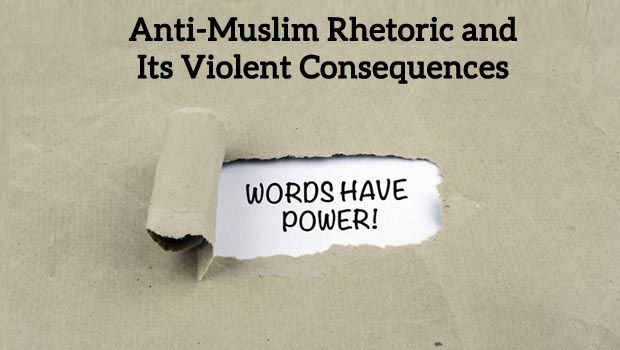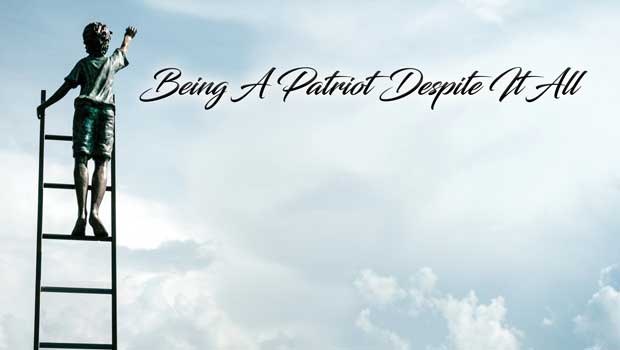It’s been a volatile summer for American Muslims.
In New York, an Imam and his assistant were brutally murdered outside a local mosque shortly following prayer services. In Oklahoma, a 37-year-old Arab American man was gunned down on his porch by his neighbor who presumed he was Muslim, less than an hour after contacting police to express fear that his soon-to-be murderer would harm him. The neighbor had previously run over the family’s matriarch with his vehicle, and then left the scene of the crime where the victim was seriously injured.
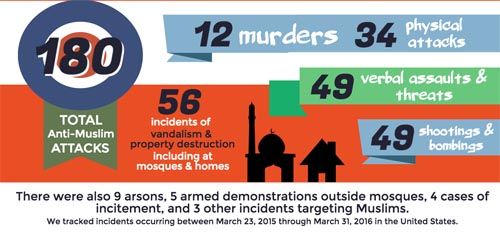 In Illinois, two American Muslim women were assaulted by another female in a parking lot. The perpetrator called them “ISIS” and bystanders encouraged her. In Texas, a caller threatened a local mosque, saying, “We will cut all of your heads off,” while describing Islam as a “violent religion” and calling for a “Christian crusade.” In South Carolina, a postcard threatened an attack against a mosque unless Dylan Roof, the white supremacist responsible for a mass shooting at a black church last year, was released.
In Illinois, two American Muslim women were assaulted by another female in a parking lot. The perpetrator called them “ISIS” and bystanders encouraged her. In Texas, a caller threatened a local mosque, saying, “We will cut all of your heads off,” while describing Islam as a “violent religion” and calling for a “Christian crusade.” In South Carolina, a postcard threatened an attack against a mosque unless Dylan Roof, the white supremacist responsible for a mass shooting at a black church last year, was released.
And, that’s just a snapshot of the most egregious acts or threats of anti-Muslim violence reported in the news media during the first few weeks of August, 2016. The month commenced with Republican presidential nominee Donald Trump’s disparaging statements about Khizr and Ghazala Khan, Gold Star parents of an American Muslim soldier who lost his life while serving his country in a controversial war in Iraq, a war premised on a claim of WMDs that never were.
As you may recall, Khizr Khan had publicly criticized Mr. Trump at the Democratic National Convention for consistently attacking the character of the American Muslim community. He questioned Mr. Trump’s sacrifices for our nation and his knowledge of the U.S. Constitution while, now famously, offering to lend his copy after pulling it out from his suit jacket pocket. Significantly, the harrowing acts and threats of anti-Muslim violence described above fit a larger pattern that has emerged during the current 2016 U.S. presidential election season.
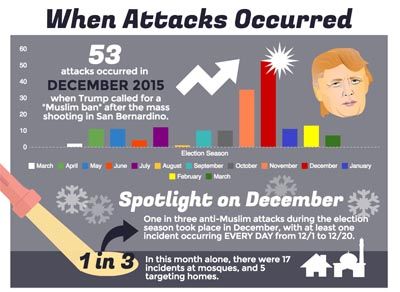 Indeed, earlier this year, Georgetown University’s Bridge Initiative, where I research, write and speak about Islamophobia, released a study titled, When Islamophobia Turns Violent: The 2016 U.S. Presidential Elections. Our study examined the relationship between anti-Muslim political rhetoric by presidential candidates and acts and threats of violence targeting the minority faith community, from March 23, 2015 through March 2016.
Indeed, earlier this year, Georgetown University’s Bridge Initiative, where I research, write and speak about Islamophobia, released a study titled, When Islamophobia Turns Violent: The 2016 U.S. Presidential Elections. Our study examined the relationship between anti-Muslim political rhetoric by presidential candidates and acts and threats of violence targeting the minority faith community, from March 23, 2015 through March 2016.
We made the following key findings:
- The 2016 U.S. presidential season began against a backdrop of already rising Islamophobia in 2015, threatening American Muslim religious freedom.
- During the course of 2015, there were approximately 174 reported incidents of anti-Muslim violence and vandalism, including: 12 murders; 29 physical assaults; 50 threats against persons or institutions; 54 acts of vandalism or destruction of property; 8 arsons; and 9 shootings or bombings, among other incidents.
- Anti-Muslim violence remained significantly higher in 2015 than pre- 9/11 levels with American Muslims approximately 6 to 9 times more likely to suffer such attacks. The number of incidents in 2015 is also higher than the total number of anti-Muslim hate crimes reported in 2014: 154.
- In 2015, American Muslim men were twice as likely to be victims of physical assaults and 5 to 6 times more likely to be victims of murder than American Muslim women.
- Since the first candidate announced his bid for the White House in March 2015, there have been approximately 180 reported incidents of anti-Muslim violence, including: 12 murders; 34 physical assaults; 49 verbal assaults or threats against persons and institutions; 56 acts of vandalisms or destruction of property; 9 arsons; and 8 shootings or bombings, among other incidents.
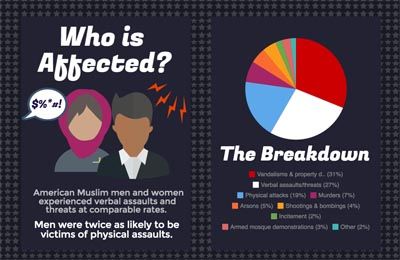
- Since the start of the presidential election cycle, American Muslim men have been twice as likely to be victims of physical assaults and about 11 times more likely to be the victims of murder than their female counterparts.
- Also during each period, Muslim murder victims were most likely to be aged 18 to 24.
- Children and youth – as young as 12 years old – were among those responsible for acts and threats of anti-Muslim violence.
- Although Islamophobia made an appearance during the first GOP debate in August 2015, the first surge of anti-Muslim political rhetoric occurred in September 2015.
- It corresponded with an international development: the Syrian refugee crisis. The deepening crises dominated news media headlines in the U.S. and Europe potentially highlighting the media impact on political discourse.
- This surge in September 2015 was accompanied by approximately 10 reported incidents or threats of violence, including 3 murders. In comparison, there was one (1) such incident in August 2015 representing a significant increase in anti-Muslim violence over the course of one month.
- Donald Trump escalated anti-Muslim vitriol in the wake of the terrorist attacks in Paris, France in November 2015 rather than urge calm or international unity. The attacks signify an international event that triggered a second surge in Islamophobic rhetoric in addition to the uptick in bias attacks.
- Trump made many anti-Muslim statements during televised appearances on mainstream news media outlets, impacting millions of viewers across the U.S. and around the world.
- As Mr. Trump called for shutting down mosques in the wake of the Paris terrorist attacks and the mass shootings in San Bernardino, California in December 2015, anti-Muslim attacks initially tripled with nearly half of those attacks directed against mosques.
- Anti-Muslim attacks surged once more in December 2015. There were 53 total attacks that month, 17 of which targeted mosques and Islamic schools and 5 of which targeted Muslim homes. By comparison, when the presidential election season began just 9 months earlier, there were only 2 anti-Muslim attacks. Attacks on Muslims during this month constitute approximately 1/3 of all attacks last year. In fact, in December 2015, anti-Muslim attacks occurred almost daily and often multiple times a day.
- At least three separate incidents of violence involved perpetrators who were public supporters of presidential candidate Donald Trump. There was otherwise a strong perception among American Muslim leaders that political rhetoric created fertile ground for threats and acts of anti-Muslim violence.
- While anti-Muslim political rhetoric gives cause for alarm, the ensuing violence has inspired expressions of solidarity with the American Muslim community, too.
Several additional observations are worth noting here. First, as highlighted above, our research demonstrated a spike in anti-Muslim violence post-Paris attack in November 2015 and again in December 2015, in the aftermath of the San Bernardino mass shooting. While the violence appeared to level off in the beginning of 2016, it still remained 3 to 5 times higher than pre-election levels. Significantly, the Paris and San Bernardino attacks by self-identifying Muslims were also accompanied by anti-Muslim political rhetoric and policy posturing by GOP presidential candidates, including now Republican presidential nominee Donald Trump.
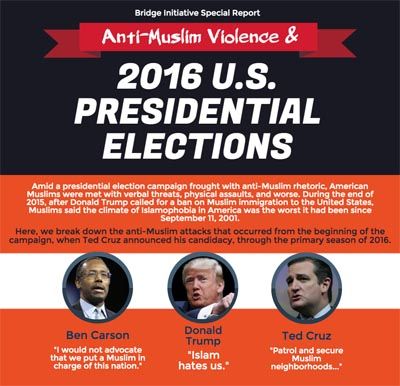 In the immediate wake of the San Bernardino attack, Trump issued a public statement calling for his now notorious ban on Muslim immigration that he continues to revisit and expand upon during press interviews and campaign rallies. It is important to highlight that many of his discriminatory remarks and proposed policies have received massive coverage in the news media, thereby amplifying the reach and impact of Trump’s Islamophobic message. His rhetoric is not only impacting hundreds or thousands of attendees at political campaign events or rallies, but millions of Americans across the country and even more people around the world.
In the immediate wake of the San Bernardino attack, Trump issued a public statement calling for his now notorious ban on Muslim immigration that he continues to revisit and expand upon during press interviews and campaign rallies. It is important to highlight that many of his discriminatory remarks and proposed policies have received massive coverage in the news media, thereby amplifying the reach and impact of Trump’s Islamophobic message. His rhetoric is not only impacting hundreds or thousands of attendees at political campaign events or rallies, but millions of Americans across the country and even more people around the world.
Second, the violence our report exposes is part of a larger trend of growing Islamophobia that pervades so many aspects of American life today. Indeed, research suggests that there has been a steady rise in Islamophobia in recent years. The FBI’s 2014 hate crime statistics, for example, show that bias crimes generally went down across the board except where American Muslims were concerned. Similarly, in 2015, the Equal Employment Opportunity Commission (EEOC), the federal government agency responsible for handling employment discrimination cases, experienced an increase in religious discrimination claims involving Muslim employees. While Muslims constitute approximately 1% to 2% of the entire U.S. population, their claims account for 40% of cases.
In addition, anti-Muslim bullying in our schools seems to be getting worse, if not evolving. A recent report from the Southern Poverty Law Center examining the impact of the presidential elections on students found that at least a 1/3 of the teacher respondents saw an increase in anti-Muslim sentiment in their classrooms. Some reported suicidal ideation among some Muslim students related to bias-based bullying. But there is an alarming trend that goes beyond conventional bullying. Whereas we typically think of school bullying as peer-on-peer harassment, research suggests that adults – essentially the very people responsible for ensuring a healthy learning environment – are increasingly the perpetrators of Islamophobia. Indeed, all of these indicators evidence Islamophobia as a growing American problem.
Finally, as our report suggests, anti-Muslim political rhetoric during the course of the presidential election season has contributed to this very real religious-freedom challenge. It is important to acknowledge other factors, however, that may help contribute to this dangerous phenomenon. The rise of ISIS, as well as actual terrorist attacks on U.S. and European soil, has also played a role, for example. This, together with foreign military interventions in Muslim majority countries such as Iraq and Afghanistan, has contributed to American fears concerning a potential enemy within our borders that constitutes a potential national security threat.
Additionally, news media coverage of terrorism as an exclusively Muslim phenomenon — even though study after study suggests that a greater domestic threat lies with far right extremists and white supremacists — helps perpetuate the stereotype of Muslims as the “terrorist other.” When an American knows a Muslim or Muslims personally, this helps counter the negative media depictions. Since Muslims only represent about 1% to 2% of the total population, however, the chances of an average American encountering Muslims at work, school or in their neighborhood is slim. Most Americans get their information about the minority faith community from whatever they consume on the computer, TV and smart phones. Research shows that last year alone, 9 out of 10 news media stories about Muslims and Islam in the U.S., U.K. and Germany were in the context of violence: war or terrorism.
So, is it truly surprising that there is a palpable fear of and hostility towards Muslims, or those perceived to be, particularly in absence of any alternative positive portrayals of the minority community? And, of course, there is the multi-million-dollar Islamophobia industry that has been exposed in the Center for American Progress’s report, Fear Inc., as well as in various CAIR publications. If there is a silver lining to growing Islamophobia in the U.S., it may be the responses of American Muslims — which have proven just as diverse as the community itself — to the stereotyping, bigotry, and threats of violence, which have proven just as diverse as the community itself. During the election season alone, we have witnessed heroic efforts to counter anti-Muslim prejudice and discrimination by the most ordinary citizens, from Rose Hamid to Khizr and Ghazala Khan. We have witnessed social media campaigns from American Muslim women, like #CanYouHearUsNow, to challenge stereotypes about, and attacks against, the minority faith community. We have also seen increased political engagement, from more voter registration drives to visible participation of Muslims at the Democratic National Convention and other political forums. We have also seen American Muslim youth showing extraordinary strength and resiliency in the face of bigotry, from Texan “clock boy” Ahmed Mohamed to Oklahoman Samantha Elauf who took her religious discrimination claim against the popular retailer Abercrombie & Fitch all the way to the U.S. Supreme Court — where she won.
It’s rather extraordinary.


